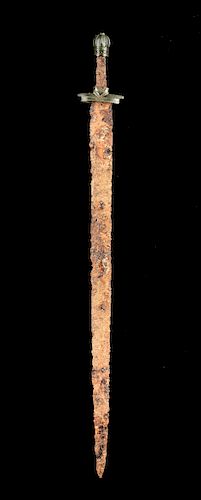Holyland Byzantine Iron / Bronze Spatha Sword
Lot 101
About Seller
Artemis Fine Arts
686 S Taylor Ave, Ste 106
Louisville, CO 80027
United States
Selling antiquities, ancient and ethnographic art online since 1993, Artemis Gallery specializes in Classical Antiquities (Egyptian, Greek, Roman, Near Eastern), Asian, Pre-Columbian, African / Tribal / Oceanographic art. Our extensive inventory includes pottery, stone, metal, wood, glass and textil...Read more
Estimate:
$4,000 - $6,000
Absentee vs Live bid
Two ways to bid:
- Leave a max absentee bid and the platform will bid on your behalf up to your maximum bid during the live auction.
- Bid live during the auction and your bids will be submitted real-time to the auctioneer.
Bid Increments
| Price | Bid Increment |
|---|---|
| $0 | $25 |
| $300 | $50 |
| $1,000 | $100 |
| $2,000 | $250 |
| $5,000 | $500 |
| $10,000 | $1,000 |
| $20,000 | $2,500 |
| $50,000 | $5,000 |
| $100,000 | $10,000 |
| $200,000 | $20,000 |
About Auction
By Artemis Fine Arts
Sep 26, 2019
Set Reminder
2019-09-26 10:00:00
2019-09-26 10:00:00
America/New_York
Bidsquare
Bidsquare : Exceptional Day 1: Antiquities & Asian Art
https://www.bidsquare.com/auctions/artemis-gallery/exceptional-day-1-antiquities-asian-art-4437
Day 1 of an important 2-day auction featuring exceptional, museum-worthy examples of Egyptian, Greek, Etruscan, Roman, Viking, Russian, Near Eastern, as well as Asian Art from China, Japan, Thailand, Vietnam, Burma and India. Artemis Fine Arts info@artemisgallery.com
Day 1 of an important 2-day auction featuring exceptional, museum-worthy examples of Egyptian, Greek, Etruscan, Roman, Viking, Russian, Near Eastern, as well as Asian Art from China, Japan, Thailand, Vietnam, Burma and India. Artemis Fine Arts info@artemisgallery.com
- Lot Description
Near East / Holy Land, Byzantine Empire, ca. 7th to 10th century CE. A handsome, large, iron-bladed sword, known as a spatha. The spatha was originally used in the early Roman Empire, inspired by the Celtic longsword, but this example is clearly Byzantine by the inclusion of its short bronze cross guard with horizontal arms and a cylindrical collar, as well as its spherical, crown like bronze pommel. This example has a flat blade with a thin profile that tapers to a sharp point. It would have been sharpened on either side. Size: 3.55" W x 35" H (9 cm x 88.9 cm)
The spatha was used for over a thousand years and in a wide geographic region. Fascinatingly many of our historical depictions of this style of sword during the Byzantine era come from religious paintings - for example, icons depicting warrior saints bearing swords just like this one. Another is found in "The Illustrations of the Homilies of Gregory of Nazianzus", a surviving manuscript made in Constantinople sometime around the 10th century CE: in the miniature "St. Gregory and Theodosius", high ranking guardsmen known as the protospatharioi stand by the emperor's suite, bearing swords just like this one in scabbards - their straight cross guards are clearly visible.
Provenance: ex-private Los Angeles, California, USA collection, acquired at auction
All items legal to buy/sell under U.S. Statute covering cultural patrimony Code 2600, CHAPTER 14, and are guaranteed to be as described or your money back.
A Certificate of Authenticity will accompany all winning bids.
We ship worldwide and handle all shipping in-house for your convenience.
#148123The iron has a weathered, pitted surface commensurate with age, with some losses along peripheries. However, the form is very well preserved. A very thin coating of plastic has been applied to the iron surface to protect it and prevent further deterioration. The guard is loose. Both bronze components have rich, dark green patinas and are well preserved.Condition
- Shipping Info
-
All shipping is handled in-house for your convenience. Your invoice from Artemis Gallery will include shipping calculation instructions. If in doubt, please inquire BEFORE bidding for estimated shipping costs for individual items.
-
- Buyer's Premium



 EUR
EUR CAD
CAD AUD
AUD GBP
GBP MXN
MXN HKD
HKD CNY
CNY MYR
MYR SEK
SEK SGD
SGD CHF
CHF THB
THB













